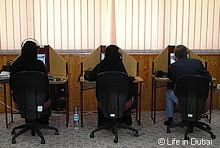
Photo. Megan Hirons. Gulf News
Congestion at the intersection near Deira City Centre where the road from the Floating Bridge meets the other roads.
The stated aim of the toll was to reduce traffic on SZR by 25% and it seems to have done that.
But that was always far too simplistic, too one-dimensional.
What about the ripple effect that so many of us have talked about for months? The pressure on the alternative roads that simply can't take the extra traffic. The pressure on the other bottlenecks, which were already full to bursting?
The already jammed Shindagah tunnel and Al Maktoum bridge are having to take even more traffic. Al Ittihad, Baniyas, Al Maktoum and Airport roads are struggling to cope with all the extra toll-avoiding and Floating Bridge traffic.
There's always a bigger picture and it's far from clear that the RTA looked at this one.
It's a fact of traffic management anywhere in the world that moving traffic more quickly from one area to another simply means that it piles up more quickly at the first obstruction. Widen SZR to six lanes each way, for example, and a bigger volume is brought more quickly to Trade Centre Roundabout, with it's sequence of traffic lights. Screech! The traffic has to stop and the queue just gets longer and longer.
Move the traffic onto Al Wasl or Beach Roads - and they hit Satwa. Screech! The traffic has to stop and the queue just gets longer and longer.
Move the traffic off Garhoud Bridge onto Maktoum or Floating bridges - and they hit Deira. Screech! The traffic has to stop and the queue just gets longer and longer.
The only way around it, overseas, has been to literally go around it - build by-pass roads that avoid the towns and cities entirely. The RTA is building many more bridges across the Creek - in itself a good move but there's no emphasis on what's really needed, roads that by-pass the city and the Creek entirely between Jebel Ali/Abu Dhabi and the northern emirates.
We need more bridges for the increasing number of people who live and/or work in Dubai and need to cross between Deira and Bur Dubai. But we deperately also need more by-pass roads for the increasing number of people who don't need or want to be clogging up the city roads at all but are forced to do so because of the road 'planning'.
By the way, have a look at the driving standards shown in the photo. The lights for traffic coming from the left are obviously green because cars are across the junction going straight ahead or filtering left. Look at the number of cars that have crossed from top right and are now blocking the intersection.
Morons.
Gulf News has the story of the increased congestion here.






3 comments:
Its not just the increase in jams that's causing problems, roads which were never meant to take this volume of traffic are quite literally breaking up, which means roadworks, which means more jams. Lovely.
The issue is a widespread one with huge interdependencies. We can only hope that 'traffic expert' Mattar Al Tayer and his people truly recognise this.
Some time ago, Arabian Business reported on a Dubai Municipality study that recommended if all current development (back then!) were taken into consideration, Sheikh Zayed Road should be widened to 60 lanes...
:)
>>Sheikh Zayed Road should be widened to 60 lanes...<<
LOL! In both directions?
Post a Comment